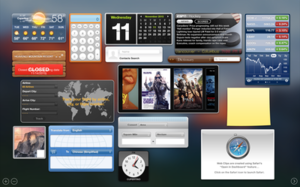 | |
 Dashboard widgets running under OS X 10.11 El Capitan | |
| Stable release | 1.8 (July 20, 2011) [±] |
|---|---|
| Operating system | Mac OS X 10.4 Tiger to macOS 10.14 Mojave |
| Type | Widget engine |
| Website | www |
| Part of a series on |
| macOS |
|---|
Dashboard is a discontinued feature of Apple Inc.'s macOS operating systems, used as a secondary desktop for hosting mini-applications known as widgets. These are intended to be simple applications that do not take time to launch. Dashboard applications supplied with macOS included a stock ticker, weather report, calculator, and notepad; while users could create or download their own.
Before Mac OS X 10.7 Lion, when Dashboard is activated, the user's desktop is dimmed and widgets appear in the foreground. Like application windows, they can be moved around, rearranged, deleted, and recreated (so that more than one of the same Widget is open at the same time, possibly with different settings). New widgets can be opened, via an icon bar on the bottom of the layer, loading a list of available apps similar to the iOS home screen or the macOS Launchpad. After loading, the widget is ready for use.
Dashboard was first introduced in Mac OS X 10.4 Tiger.[1][2][3] It can be activated as an application, from the Dock, Launchpad, or Spotlight. It can also be accessed by a dashboard key.[4] Alternatively, the user can choose to make Dashboard open on moving the cursor into a preassigned hot corner or keyboard shortcut. Starting with Mac OS X 10.7 Lion, the Dashboard can be configured as a space, accessed by swiping four fingers to the right from the Desktops either side of it.
From OS X 10.10 Yosemite onward, the Dashboard was disabled by default, with the Notification Center becoming the primary method of displaying widgets. As of macOS 10.15 Catalina, Dashboard has been removed from macOS.[5]
Widget support is reintroduced in macOS Sonoma, released in 2023.[6] In macOS Sonoma, Apple has integrated the Dashboard with the Desktop. Users are still able to keep widgets in the Notification Center.
- ^ "How to create your own OS X Dashboard Widgets from Safari - Make Tech Easier". Make Tech Easier. July 26, 2010. Archived from the original on August 18, 2021. Retrieved January 8, 2017.
- ^ Haslam, Karen. "Yosemite review: Continuity and WiFi problems mar an otherwise pleasing update". Macworld UK. Archived from the original on August 19, 2015. Retrieved January 10, 2017.
- ^ Udell, Sterling (April 6, 2010). Pro Web Gadgets for Mobile and Desktop. Apress. ISBN 9781430225522. Archived from the original on April 24, 2023. Retrieved November 10, 2020.
- ^ Hattersley, Lucy. "3 ways to Mac Dashboard useful again: games, entertainment and fresh new productivity widgets". Macworld UK. Archived from the original on July 26, 2020. Retrieved January 13, 2017.
- ^ Statt, Nick (June 4, 2019). "Apple will permanently remove Dashboard in macOS Catalina". The Verge. Archived from the original on January 16, 2021. Retrieved June 5, 2019.
- ^ Porter, Jon (June 5, 2023). "Apple announces macOS Sonoma with game mode and support for desktop widgets". The Verge. Archived from the original on June 5, 2023. Retrieved June 8, 2023.